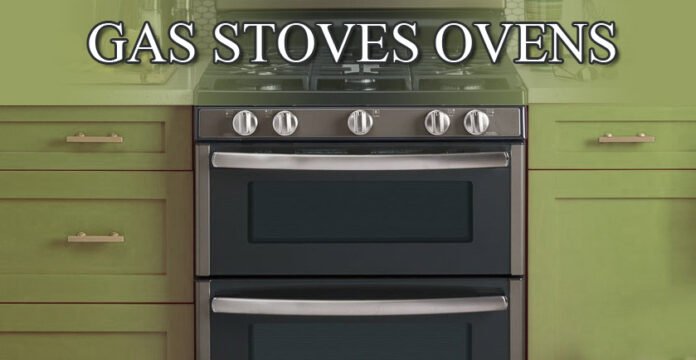Gas Stoves vs Built-In Gas Ovens
Choosing between gas stoves vs built-in ovens is a common decision for American homeowners upgrading their kitchen. Each option has unique advantages depending on your layout, cooking style, and space.
When remodelling your kitchen or replacing outdated appliances, one common dilemma is whether to go with a traditional gas stove or a built-in gas oven. Both options have their unique advantages, and your decision largely depends on kitchen layout, cooking habits, and design preferences.
In this guide, we’ll break down the differences, pros and cons, and help you choose the best fit for your home. Whether you love to cook daily meals or bake occasionally, this comparison will help you make an informed purchase—plus, we’ve included our top recommended models from trusted brands like GE, Frigidaire, and Bosch.
🔎 Disclosure: This post contains affiliate links. As an Amazon Associate, we may earn commissions from qualifying purchases—at no extra cost to you.
What’s the Difference Between Gas Stoves and Built-In Gas Ovens?
At first glance, both gas stoves and built-in gas ovens serve the same basic purpose—cooking food with gas-powered heat. But they are structured very differently and suit different types of kitchens.
Gas Stove (or Range)
A gas stove, often called a gas range, combines a cooktop and an oven in one freestanding unit. It typically stands alone and slides between cabinets, requiring minimal custom installation.
- ✅ Ideal for: Traditional kitchen layouts, renters, or homeowners looking for an all-in-one appliance.
- 🔌 Requires: Gas hookup and electrical outlet (for ignition and lighting).
Built-In Gas Oven
A built-in gas oven is installed directly into your kitchen cabinetry, usually below the countertop or into a wall unit. It often requires a separate gas cooktop, offering more flexibility in kitchen design.
- ✅ Ideal for: Modern kitchens, small apartments, or homeowners who want a seamless look.
- 🔧 Requires: Professional installation and custom cabinetry cutout.
Key Differences Table
| Feature | Gas Stove (Range) | Built-In Gas Oven |
|---|---|---|
| Installation | Freestanding | Built into wall/cabinet |
| Includes Cooktop | Yes | No (cooktop sold separately) |
| Kitchen Fit | Standard | Customizable, sleek look |
| Space Efficiency | Moderate | High (saves counter space) |
| Cost (Unit + Install) | Lower | Higher upfront |
Pros and Cons of Gas Stoves
✅ Advantages of Gas Stoves
- All-in-One Convenience: Oven + cooktop combo in one unit
- Easy Installation: No need to install separate units
- Cost-Effective: Typically more budget-friendly than a built-in setup
- Portable: Easier to remove or upgrade later
- Wide Availability: Many models from major US brands under $1,000
❌ Disadvantages of Gas Stoves
- Bulky Design: Takes up more kitchen floor space
- Less Design Flexibility: Fixed layout, harder to customize
- Can Look Outdated: Compared to sleek modern built-in kitchens
🔎 Best for: Families who want simplicity, affordability, and don't need a high-end kitchen layout.
Pros and Cons of Built-In Gas Ovens
✅ Advantages of Built-In Gas Ovens
- Space-Saving: Perfect for small kitchens and open floor plans
- Sleek, Integrated Design: Matches modern cabinetry and décor
- Flexible Placement: Can be installed under counters or in walls
- Separate Cooktop Options: Pair with gas, induction, or electric cooktops
- More Storage Options: Frees up room for drawers and base cabinets
❌ Disadvantages of Built-In Gas Ovens
- Higher Upfront Cost: Oven + cooktop + installation can add up
- Permanent Installation: Not ideal for renters or frequent movers
- No Cooktop Included: Must be purchased separately
🔎 Best for: Homeowners remodeling for long-term use, modern apartment dwellers, or anyone prioritizing a streamlined kitchen aesthetic.
Top Picks – Best Models for Gas Stoves vs Built-In Ovens (2025)
When it comes to choosing between gas stoves vs built-in gas ovens, understanding your top-rated options makes all the difference. We’ve reviewed dozens of models based on performance, features, price, and user reviews. Below is a quick comparison to help you find what fits your kitchen—and your budget.
🔹 Best Gas Stoves for Everyday Use
| Product | Key Features | Price Range | Buy Link |
|---|---|---|---|
| GE JGBS66REKSS | 5 sealed burners, 5.0 cu. ft. oven, convection, self-cleaning | $700–$900 | Check on Amazon |
| Frigidaire FFGF3054TS | 5 burners, large window, continuous grates, stainless steel | $800–$950 | View on Amazon |
| Samsung NX58R4311SS | 5.8 cu. ft. oven, auto shut-off, continuous grates | $850–$1,000 | Shop on Amazon |
🛠️ Need more options? Check out our full guide to the best gas ranges for home kitchens.
🔹 Top Built-In Gas Ovens for Small Kitchens
| Product | Key Features | Price Range | Buy Link |
|---|---|---|---|
| Bosch HBL5451UC 500 Series | 4.6 cu. ft., European convection, stainless steel finish | $1,500–$1,800 | Check on Amazon |
| Empava 24” Gas Wall Oven | 2.3 cu. ft., tempered glass, convection fan, CSA certified | $600–$800 | View on Amazon |
| Frigidaire FFGW2426US | 3.3 cu. ft., ADA compliant, fan-assisted, stainless | $1,000–$1,200 | Shop on Amazon |
✅ Want a space-saving setup? Explore our best wall ovens for small kitchens.
⚙️ How to Choose Between Gas Stoves vs Built-In Ovens
Still not sure which appliance wins the gas stoves vs built-in gas ovens showdown? Here’s what to think about before you hit “Add to Cart”:
🏠 1. Kitchen Layout and Size
- Limited floor space? A built-in oven under the counter paired with a separate cooktop can free up valuable real estate.
- Renovating or starting from scratch? Built-ins are perfect for modern designs.
- Rental or existing layout? Gas stoves are easier to install without major changes.
Tip: For small homes or apartments, check out our guide to the best kitchen appliances for limited space.
🍳 2. Cooking Habits
- Do you cook daily meals or just occasional baking?
- Gas stoves are better for frequent stovetop use.
- Built-in ovens are ideal for home bakers who want even heating and modern features.
💡 Did you know? Some wall ovens come with convection roasting and dehydrating—great for multi-function cooking!
💡 3. Energy Efficiency and Cost
- Gas is generally cheaper than electric in the long run, especially in areas like California and Texas.
- Built-in ovens often come with high-efficiency convection fans and insulated designs that reduce heat loss.
🔗 External Resource: U.S. Department of Energy – Appliance Energy Use
🔧 4. Installation Requirements
- Gas stoves are plug-and-play if you already have a gas line.
- Built-in ovens usually require:
- Professional installation
- Custom cabinetry cutout
- Dedicated electrical and gas hookups
🔎 Looking to upgrade the entire cooking area? Our gas cooktop buying guide covers top picks that pair well with built-in ovens.
📌 Pro Tip: Before purchasing any gas appliance, always check local building codes, gas availability, and safety regulations.
👉 Want Help Choosing?
Use our interactive comparison tool in the full guide: Compare Gas Stoves vs Built-In Ovens →
Maintenance & Cleaning: What to Expect
When comparing gas stoves vs built-in gas ovens, one area that often gets overlooked is how easy they are to clean and maintain. The truth? Each has its own cleaning challenges—but some smart features make the job easier.
🔹 Gas Stove Maintenance Tips
- Burner grates need regular wiping with degreaser or soap and water.
- Spills around the burners can be tough to reach—use a soft brush or old toothbrush.
- Many models now come with sealed burners, reducing food seepage into hard-to-clean gaps.
✅ Recommended product: Weiman Gas Range Cleaner & Degreaser – safe for all stovetops.
Weekly routine:
- Remove grates and soak
- Wipe down cooktop surface
- Scrub burner heads with a mild abrasive
- Dry thoroughly before reassembling
🔹 Built-In Oven Maintenance Tips
Most modern built-in ovens include:
- Self-cleaning cycles
- Easy-clean enamel interiors
- Removable doors or racks
Cleaning process:
- Run self-cleaning (if available)
- Use a vinegar-based solution or oven cleaner for grease spots
- Remove racks and clean separately
- Wipe glass door with a microfiber cloth
🛑 Never use harsh metal brushes or ammonia inside the oven. It can damage the enamel.
Need more help? Read our full guide: How to Clean a Gas Oven Without Chemicals
🛡️ Safety Tips for Using Gas Appliances
Whether you’re installing a new gas range or upgrading to a built-in model, kitchen safety is non-negotiable. Here’s what to watch for:
🔥 1. Install a Gas Leak Detector
- Essential for both stoves and ovens
- Mount low to the ground near the appliance
- Test monthly
📦 Recommended: Kidde Gas Leak Detector on Amazon
🧤 2. Always Use Oven Mitts
- Don’t rely on kitchen towels
- Use heat-resistant silicone gloves to prevent burns
👶 3. Childproof Your Kitchen
- Install oven locks if you have toddlers
- Keep knobs covered to prevent accidental ignition
🧯 4. Keep a Fire Extinguisher Nearby
- Type B is best for kitchen grease fires
- Store within arm’s reach but away from heat
💨 5. Ventilation is Critical
- Always use a range hood or open window
- Avoid buildup of gas fumes or carbon monoxide
Want more peace of mind? Read our article on Gas Stove Safety Tips Every Homeowner Should Know
❓ FAQs – Gas Stoves vs Built-In Gas Ovens
Add FAQ Schema here (Yoast SEO > Schema > FAQ)
What is more energy-efficient: a gas stove or a built-in oven?
Both use natural gas, which is more affordable than electricity in most US states. However, built-in ovens with convection fans can cook faster, reducing energy consumption over time.
Can I install a built-in gas oven myself?
Not recommended. Built-in ovens require:
- Proper venting
- Gas line connection
- Wall-mounting or cabinet integration
Always hire a licensed technician.
Are gas ovens better for baking than electric?
Yes—for many chefs, gas ovens provide moist heat, which is ideal for baking breads and roasts. However, they may not distribute heat as evenly without a fan.
Can I use a gas stove during a power outage?
Yes—for cooking on burners, you can ignite them with a lighter. However, the oven ignition and lighting may be disabled during a power outage if it’s electronically controlled.
🎯 Gas Stoves vs Built-In Ovens: Which One Is Right for You?
Let’s recap:
| Choose If You… | Go For This |
|---|---|
| Want simplicity + all-in-one appliance | ✅ Gas Stove |
| Have a small or modern kitchen | ✅ Built-In Gas Oven |
| Bake often and need precision | ✅ Built-In Gas Oven |
| Need budget-friendly, quick install | ✅ Gas Stove |
🛒 Ready to Make a Decision?
✅ Shop Top-Rated Gas Stoves and Built-In Ovens on Amazon
📦 Don’t forget to bundle with a matching gas cooktop or range hood





